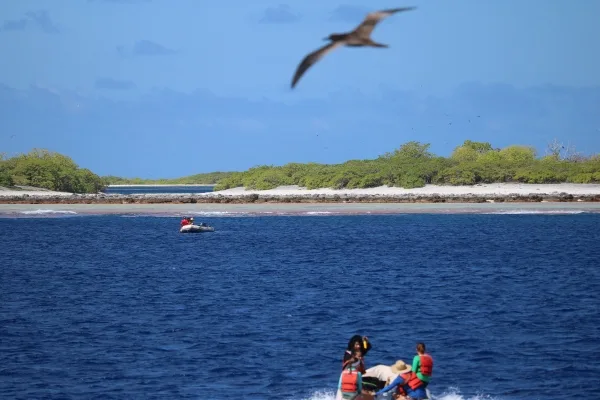Programs Blog
Arrival at Caroline Island

Rowan DeWitt, C watch, sophomore at Lake Forest College in Illinois
Ship’s Log
Current Position
9° 57.5’ S x 150° 13.6’ W, off the coast of Caroline Island
Ship’s Heading and Speed
Motor intermittently to stay in position
Sail Plan
None
Weather
Sunny with some puffy clouds, very calm seas
I started today at about 3 in the morning, when I failed to wake up on time for my watch. I eventually got on deck in time to catch the briefing from the previous watch, and was subsequently assigned to clean the dishes from last night’s dinner. (This wasn’t a punishment or anything – I was scheduled for dishes duty today). After scrubbing everything clean and brewing a fresh pot of coffee, I went back to help out on deck.
The previous watch had done a neuston net tow and a water sample around midnight, and it was up to our watch to process it. When I peeked into the lab to see how it was going, they were busy shaking lantern fish out of a test tube. They also showed me a bucket where they had pulled in a couple of small man-o-war jellyfish, as well as a baby flying fish. I was eventually stationed at lookout, on the front of the ship. I sat in the dark for quite a while, watching the clouds move and the ocean swell. Eventually, the first hints of the sunrise touched the horizon. Around the same time, I spotted it – land!
As we got closer, the small trees came into view. Caroline Island is completely uninhabited, and as a result is in great condition ecologically. Lots of birds – Blue-Footed Boobies, Terns, and Frigate Birds – were flocking on and around the ship as sunlight broke through the clouds and lifted the mist from the island.
The only thing that broke my reverie was Nate. Nate, our chief engineer, apparently likes to meditate as the sun rises. This is great and all, but I wasn’t aware of this beforehand. As a result, he only appeared as a shadow for about 45 minutes until it got light enough to see. At some point that morning, I noticed him standing nearby. It was too dark to make out any features, so for the longest time all I knew was that there was some thing,
human-shaped and motionless, watching me. I fully expected that if I took my eyes off of it for too long, for example to look at the approaching island or the beautiful sunrise, the thing would appear right behind me and push me off into the ocean or something. If you need to wake up in the morning, this works better than coffee.
Finally we reached the island. The sea floor around the island prevented us from anchoring, so we decided that the best way to stay nearby was to use the motor to get as close the shore as comfortable, and allow the current to pull us back. The reef on Caroline Island is what’s called an Atoll Reef. There isn’t a central island, but rather a ringlet of old coral islets, or motus, with some trees on them. This means that it slopes up from the sea floor (very steeply in this case, which was why we weren’t able to anchor) into the reef. The coral then goes all the way up to the shore, where the waves break over the top of it.
We took the small boats in closer to the shore so that we wouldn’t have to swim the whole way there, and then we hopped in. The reef was huge. There was an amazing variety of coral, as well as tons of fish. We saw everything from small pencil-shaped fish gathered near the surface to huge groupers tucked away in crevices. We also saw a bunch of black-tipped reef sharks, and a few people spotted an eagle ray.
I finished my day off by staring into the sky. The darkness before the moon rises gives me the best view I’ve ever had of the stars. I can see the Milky Way, satellites, and more shooting stars than I can count. It’s a great way to fall asleep.
– Rowan DeWitt, C watch, sophomore at Lake Forest College in Illinois
Recent Posts from the Ships
- Ocean Classroom 2024-A collaborative high school program with Proctor Academy
- Collaborations and Long-term Commitments: SEA’s Caribbean Reef Program Sets a Course for Coastal Programs that Compliment Shipboard Experiences.
- Sea Education Association students prepare for life underway using state of the art nautical simulation from Wartsila Corporation.
- SEA Writer 2022, Magazines From the Summer SEA Quest Students
- Technology@SEA: Upgrades Allow Insight into Ocean Depths
Programs
- Gap Year
- Ocean Exploration
- High School
- Science at SEA
- SEA Expedition
- SEAScape
- Pre-College
- Proctor Ocean Classroom
- Protecting the Phoenix Islands
- SPICE
- Stanford@SEA
- Undergraduate
- Climate and Society
- Climate Change and Coastal Resilience
- Coral Reef Conservation
- Marine Biodiversity and Conservation
- MBL
- Ocean Exploration: Plastics
- Ocean Policy: Marine Protected Areas
- Oceans and Climate
- Pacific Reef Expedition
- The Global Ocean: Hawai'i
- The Global Ocean: New Zealand